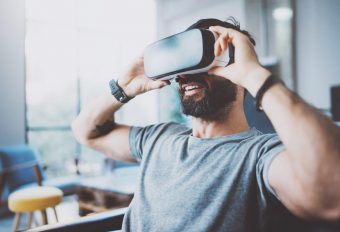When we talk about Virtual Reality (VR), many of us think of science fiction films like ‘Minority Report’. However, the truth is that nowadays, this technology completely blends in with our daily lives. Video games, medicine, education… Virtual Reality is here to stay. But what is it exactly?
Virtual Reality (VR) is a computer-generated environment with scenes and objects that appear to be real, making the user feel they are immersed in their surroundings. This environment is perceived through a device known as a Virtual Reality headset or helmet. VR allows us to immerse ourselves in video games as if we were one of the characters, learn how to perform heart surgery or improve the quality of sports training to maximise performance.

Although this may seem extremely futuristic, its origins are not as recent as we might think. In fact, many people consider that one of the first Virtual Reality devices was called Sensorama, a machine with a built-in seat that played 3D movies, gave off odours and generated vibrations to make the experience as vivid as possible. The invention dates back as far as the mid-1950s. Subsequent technological and software developments over the following years brought with them a progressive evolution both in devices and in interface design.

DIFFERENCES WITH AUGMENTED REALITY
Despite being a technology that originated decades ago, many people are still unfamiliar with the concept of Virtual Reality. It is also quite common to confuse the term Virtual Reality with augmented reality. The main difference between the two is that VR builds the world in which we immerse ourselves through a specific headset. It is fully immersive and everything we see is part of an environment artificially constructed through images, sounds, etc.
The main difference between the two is that VR builds the world in which we immerse ourselves through a specific headset. It is fully immersive and everything we see is part of an environment artificially constructed through images, sounds, etc. On the other hand, in augmented reality (AR), our own world becomes the framework within which objects, images or similar are placed. Everything we see is in a real environment and it may not be strictly necessary to wear a headset. The clearest and most mainstream example of this concept is Pokémon Go.
Which treats of the character and pursuits of the famous gentleman Don Quixote of La Mancha
In a village of La Mancha, the name of which I have no desire to call to mind, there lived not long since one of those gentlemen that keep a lance in the lance-rack, an old buckler, a lean hack, and a greyhound for coursing. An olla of rather more beef than mutton, a salad on most nights, scraps on Saturdays, lentils on Fridays, and a pigeon or so extra on Sundays, made away with three-quarters of his income.
The rest of it went in a doublet of fine cloth and velvet breeches and shoes to match for holidays, while on week-days he made a brave figure in his best homespun. He had in his house a housekeeper past forty, a niece under twenty, and a lad for the field and market-place, who used to saddle the hack as well as handle the bill-hook. The age of this gentleman of ours was bordering on fifty; he was of a hardy habit.
However, there is also a combination of both realities called mixed reality. This hybrid technology makes it possible, for example, to see virtual objects in the real world and build an experience in which the physical and the digital are practically indistinguishable.
MAIN APPLICATIONS OF VIRTUAL REALITY

That’s enough about the theory that is projecting us into the future. Which sectors is Virtual Reality actually being used in today? Medicine, culture, education and architecture are some of the areas that have already taken advantage of this technology. From guided museum visits to the dissection of a muscle, VR allows us to cross boundaries that would otherwise be unimaginable.The main difference between the two is that VR builds the world in which we immerse ourselves through a specific headset. It is fully immersive and everything we see is part of an environment artificially constructed through images, sounds, etc.
Nowadays, the market is demanding applications that go beyond leisure, tourism or marketing and are more affordable for users. Virtual interfaces also need to be improved to avoid defects such as clipping, which makes certain solid objects appear as though they can be passed through. Or to minimise the effects that VR produces in people, among them motion sickness, which consists of a dizziness induced by the mismatch between the movement of our body and what is being seen in the virtual world.
 The International Mall
The International Mall 



